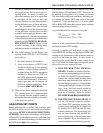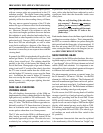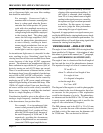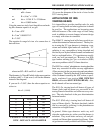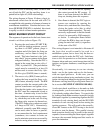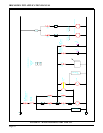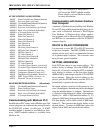
IRIS MODEL P522 APPLICATION MANUAL
Page 25
Area circle = πR
2
πR
2
= 4mm
2
so R = (4/π)
-2
= 1.1284
and dia = 1.1284 X 2 = 2.2568mm
or dia = 0.0889 inches
Using the same two-inch, focal-length lens and mak-
ing this diameter equal to d, we get:
θ = 2 tan
-1
d/2F
θ = 2 tan
-1
0.0889/2 X 2
θ = 2.545°
The equation for angel of view of a camera lens is
derived from:
where tan θ/2 = R/L and R = L tan θ/2
The diameter d = 2Ltan θ/2 which is the same equation
as before with F = L but now d, will be the diameter
instead of the diagonal.
If you use θ = 2.545°, then the above equation re-
solves to:
dia = L (.0444)
The table in Figure 10 shows the various distances
(L) versus the diameter of the circle of view for the
S512 viewing head.
APPLICATION OF IRIS
VIEWING HEADS
It is impossible to provide steadfast rules for each
type of viewing head and what application it should
be used for. The applications are becoming more
difficult because of the wide range of fuels being
used, in addition to recent changes in burner design
to comply with clean air standards.
The S506 UV viewing head will always result in ex-
cellent discrimination between burners. The key fac-
tor in using the UV type detector is obtaining a con-
sistent and reliable signal under all conditions. UV
radiation is very susceptible to being absorbed and
blocked by non-hydrocarbon elements and unburned
fuel, as explained before. UV type detectors usually
work very well on natural gas. However, low NOx
type burners utilizing fuel gas recirculation (FGR)
can cause problems with UV flame detection.
The S509 “two-colour” photodetector viewing head has
been very successful in sulfur recovery applications
(Claus reactors) in the gas processing and petrochemi-
cal industries. The basic drawback is the nonlinearity
of the Si channel caused by the AGC action, as previ-
ously explained (see section S509 VIEWING
HEAD, and section S512 VIEWING HEAD). Also,
the Si channel will not see natural gas.
The S511 Ge viewing head will detect all types of
flames (fuels) and has been very successful in de-
tecting flame in lime kilns and sulfur recovery reac-
tors. The only drawback is the poor discrimination
between burners.
The S512 (PbS only) viewing head will detect all
types of flames (fuels). The basic drawback (which
can be corrected by orificing) is the photodetector
saturation on bright flames.
In general, flicker-type detectors work very well
when the combustion air, at the root of the burner, is
turbulent. They work better on heavy oil and pul-
verized coal flames than on natural gas flames. Natu-
ral gas burners usually exhibit lower flicker frequen-
L
R
θ
LAID
TFSEHCNISEHCNI
24270.1
36306.1
62702.3
2144193.6
6129135.8
FIGURE 10 - VIEWING HEAD: ANGLE OF
VIEW - DISTANCE AND DIAMETER



